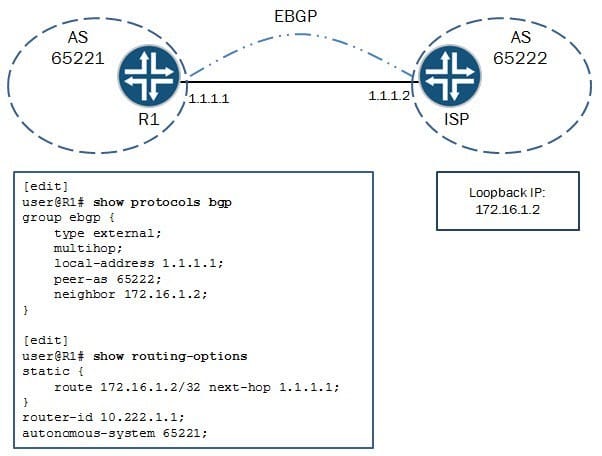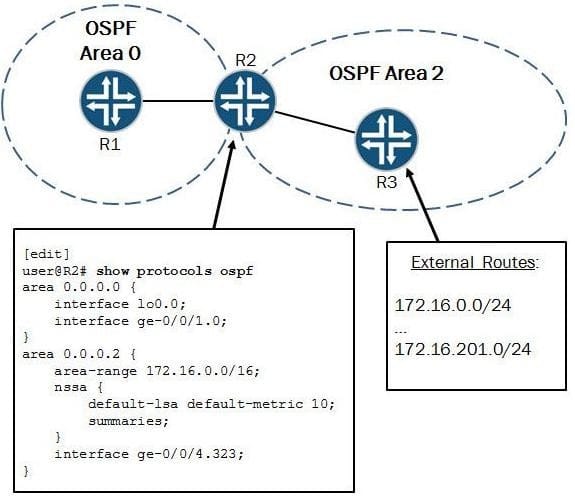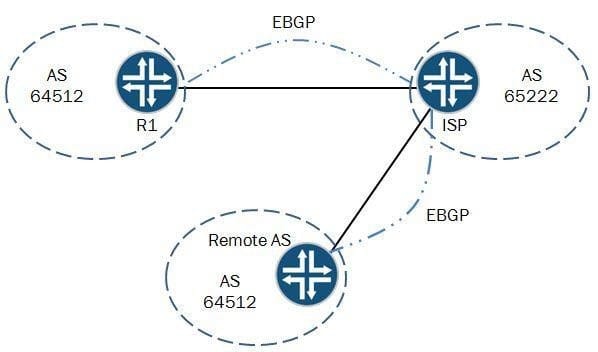JN0-694 Online Practice Questions and Answers
You are troubleshooting a problem where an OSPF adjacency between two neighboring routers will not
form.
What are two reasons for this problem? (Choose two.)
A. One or both of the connected interfaces are missing the family inet statement.
B. One or both of the connected interfaces are missing the family iso statement.
C. The connected interfaces are not on the same subnet.
D. Another IGP is running on one or both of the routers, overriding OSPF.
Your Junos device is dropping certain traffic flows, while allowing other traffic flows to pass through the device unaffected.
Which CoS component is causing this problem?
A. BA classification
B. RED
C. MF classification
D. Rewrite rules
Two neighboring routers are able to form an OSPF adjacency, but are not able to establish an IBGP neighborship.
What are two reasons for the IBGP neighborship problem? (Choose two.)
A. One of the devices has a misconfigured BGP peer address.
B. One or both of the connected interfaces are missing the family iso statement.
C. OSPF has a lower route preference than BGP.
D. A firewall filter on one of the interfaces is blocking TCP traffic.
You recently deployed two Anycast RPs. Multicast clients in the network are reporting that they are receiving traffic from some, but not all, multicast sources.
What are two solutions for this problem? (Choose two.)
A. Configure MSDP between the Anycast RPs.
B. Configure rp-set for the Anycast RPs.
C. Configure multicast BGP between the Anycast RPs.
D. Configure the network to always use the RPT and not switch over to the SPT.
-- Exhibit -user@router# run show log ospf-test ... Jun 10 22:35:38.598494 OSPF sent Hello 10.100.0.1 -> 224.0.0.5 (ge-1/0/3.1000 IFL 77 area 0.0.0.0) Jun 10 22:35:38.598520 Version 2, length 44, ID 10.100.1.2, area 0.0.0.0 Jun 10 22:35:38.598543 mask 255.255.255.252, hello_ivl 10, opts 0x2, prio 128 Jun 10 22:35:38.598564 dead_ivl 32, DR 10.100.0.1, BDR 0.0.0.0 Jun 10 22:35:41.522956 OSPF periodic xmit from 10.200.26.1 to 224.0.0.5 (IFL 2684276196 area 0.0.0.1) Jun 10 22:35:42.798220 OSPF rcvd Hello 10.100.0.2 -> 224.0.0.5 (ge-1/0/3.1000 IFL 77 area 0.0.0.0) Jun 10 22:35:42.798311 Version 2, length 48, ID 10.100.1.1, area 0.0.0.0 Jun 10 22:35:42.798334 checksum 0x0, authtype 0 Jun 10 22:35:42.798356 mask 255.255.255.252, hello_ivl 10, opts 0x2, prio 128 Jun 10 22:35:42.798377 dead_ivl 40, DR 10.100.0.2, BDR 10.100.0.1 Jun 10 22:35:45.189034 OSPF rcvd Hello 10.100.0.2 ->
224.0.0.5 (ge-1/0/3.1000 IFL 77 area 0.0.0.0) Jun 10 22:35:45.189097 Version 2, length 44, ID 10.100.1.1, area 0.0.0.0 Jun 10 22:35:45.189118 checksum 0x0, authtype 0 Jun 10 22:35:45.189140 mask 255.255.255.252, hello_ivl 10, opts 0x2, prio 128 Jun 10 22:35:45.189162 dead_ivl 40, DR 10.100.0.2, BDR 0.0.0.0 Jun 10 22:35:45.196969 OSPF DR is 10.100.1.2, BDR is 0.0.0.0 Jun 10 22:35:45.197050 OSPF sent Hello 10.200.26.1 -> 224.0.0.5 (ge-1/0/0.0 IFL 69 area 0.0.0.1) Jun 10 22:35:45.197076 Version 2, length 44, ID 10.100.1.2, area 0.0.0.1 Jun 10 22:35:45.197098 mask 255.255.255.252, hello_ivl 10, opts 0x2, prio 128 Jun 10 22:35:45.197119 dead_ivl 40, DR 10.200.26.1, BDR 0.0.0.0 Jun 10 22:35:46.746900 OSPF periodic xmit from 10.100.0.1 to 224.0.0.5 (IFL 2684276196 area 0.0.0.0) -- Exhibit -
Click the Exhibit button.
Referring to the exhibit, what is preventing the OSPF neighborship with two directly connected routers using interface ge-1/0/3 from reaching the full state?
A. dead interval mismatch
B. authentication type mismatch
C. subnet mismatch
D. hello interval mismatch
-- Exhibit -user@router> show ospf database
Area 0.0.0.1 Type ID Adv Rtr Seq Age Opt Cksum Len Router 172.24.255.1 172.24.255.1 0x800000d4 182 0x22 0x59f3 36 Router 172.24.255.2 172.24.255.2 0x800000d4 177 0x22 0x57f2 36 Router *172.24.255.4 172.24.255.4 0x800000dc 176 0x22 0x75fa 72 Network 172.24.124.2 172.24.255.2 0x80000007 177 0x22 0x7957 36 Summary 172.24.13.0 172.24.255.1 0x80000004 2370 0x22 0x3f62 28 Summary 172.24.23.0 172.24.255.1 0x80000002 471 0x22 0xdeb9 28 Summary 172.24.255.1 172.24.255.1 0x800000cb 2037 0x22 0x2bbb 28 Summary 172.24.255.2
172.24.255.2 0x800000cc 487 0x22 0x19ca 28 Summary 172.24.255.3 172.24.255.1 0x80000003 140 0x22 0xb2f9 28 OSPF AS SCOPE link state database Type ID Adv Rtr Seq Age Opt Cksum Len Extern *1.47.82.0 172.24.255.4 0x80000002 1037 0x22 0x4225 36 Extern *100.0.0.0 172.24.255.4 0x80000001 2643 0x22 0xfc88 36
user@router> show ospf neighbor Address Interface State ID Pri Dead
172.24.124.2 ge-0/0/1.0 Full 172.24.255.2 128 36
172.24.124.1 ge-0/0/1.0 Full 172.24.255.1 128 30
user@router> show ospf interface ge-0/0/1.0 extensive Interface State Area DR ID BDR ID Nbrs ge-0/0/1.0 PtToPt 0.0.0.1 0.0.0.0 0.0.0.0 2 Type: P2MP, Address: 172.24.124.4, Mask: 255.255.255.0, MTU: 1500, Cost: 1 Adj count: 2 Hello: 10, DeaD. 40, ReXmit: 5, Not Stub Auth type: None Protection type: None Topology default (ID 0) -> Cost: 1 user@router> show route protocol ospf table inet.0
inet.0: 11133 destinations, 11135 routes (11133 active, 0 holddown, 0 hidden) + = Active Route, - = Last Active, * = Both
224.0.0.5/32 *[OSPF/10] 1w0d 00:01:14, metric 1 MultiRecv -- Exhibit -
Click the Exhibit button.
Referring to the exhibit, why are the OSPF routes missing from the routing table for this router?
A. mismatching OSPF interface type with the neighbor
B. MTU mismatch with the neighbor
C. incorrect IP address configured on the interface
D. no Type 4 LSAs in the OSPF database
-- Exhibit

-- Exhibit -
Click the Exhibit button.
You are asked to configure a multihop EBGP peering to a loopback address of your ISP. The peering does
not establish, and the ISP has verified that the settings are correct on their side.
Referring to the exhibit, what is causing the problem?
A. The peer-as parameter is misconfigured.
B. The local-address parameter is misconfigured.
C. The static route is misconfigured.
D. The neighbor parameter is misconfigured.
-- Exhibit -user@router# show class-of-service
classifiers {
inet-precedence ipp-test {
import default;
forwarding-class best-effort {
loss-priority low code-points be;
}
forwarding-class expedited-forwarding {
loss-priority low code-points af21;
}
forwarding-class assured-forwarding {
loss-priority low code-points af11;
}
forwarding-class network-control {
loss-priority low code-points nc1;
}
}
}
interfaces {
ge-* {
scheduler-map map-test;
unit * {
classifiers {
inet-precedence ipp-test;
}
rewrite-rules {
inet-precedence ipp-rw-test;
inet-precedence default;
}
}
}
}
...
rewrite-rules {
inet-precedence ipp-rw-test {
forwarding-class best-effort {
loss-priority low code-point be;
loss-priority high code-point af21;
}
forwarding-class expedited-forwarding {
loss-priority high code-point af21;
loss-priority low code-point be;
}
forwarding-class assured-forwarding {
loss-priority low code-point af11;
loss-priority high code-point af11;
}
forwarding-class network-control {
loss-priority low code-point nc1;
loss-priority high code-point nc1;
}
}
}
user@router> show class-of-service
...
Code point type: inet-precedence
Alias Bit pattern af11 001 af21 010 af31 011 af41 100 be 000 cs6 110 cs7 111 ef 101 nc1 110 nc2 111 -- Exhibit -
Click the Exhibit button.
Traffic with the IP precedence value af21 ingresses the router and should be rewritten with the same value as it egresses; however, this traffic is rewritten to a different value.
Referring to the exhibit, what is the source of this problem?
A. The BA classifier is assigning the traffic to the best-effort queue with a high loss priority.
B. The BA classifier is assigning the traffic to the best-effort queue with a low loss priority.
C. The BA classifier is assigning the traffic to the expedited forwarding queue with a high loss priority.
D. The BA classifier is assigning the traffic to the expedited forwarding queue with a low loss priority.
You are troubleshooting a problem where external routes are not being summarized into the OSPF backbone.

Referring to the exhibit, what needs to be done to resolve this problem?
A. The area-range parameter needs to be under Area 0.
B. The area-range parameter needs to be under the nssa hierarchy.
C. The summaries parameter needs to be removed under the/issa hierarchy.
D. The area-range parameter must include the override-metric parameter.
You want to receive routes from a remote EBGP peer as shown in the exhibit. The remote site has the same AS number as your own. You have successfully established the EBGP peering, but are not receiving any routes.
Which BGP group configuration parameter will enable you to receive routes from the remote EBGP peer?

A. advertise-inactive
B. multipath
C. as-override
D. remove-private